University Business Project: Elderly Day Care in Maldives
VerifiedAdded on 2022/12/27
|72
|19619
|4
Project
AI Summary
This project is a comprehensive business development plan for an elderly day care center in the Maldives. It begins with an introduction outlining the business concept, rationale, research questions, and objectives. A detailed literature review explores the existing research on elderly care, including the role of technology, quality of life considerations, and challenges in care homes. The research methodology section details the research design, instruments, and data collection methods used. The core of the project lies in the data analysis, covering product, market, industry, organizational, and financial feasibility. A business model canvas is presented, followed by a detailed business plan including vision, mission, marketing, operations, human resources, risk assessment, and financial projections. The financial plan includes cash budgets, income statements, balance sheets, breakeven analysis, sensitivity analysis, ratio analysis, and cost management strategies. Finally, a schedule for implementation is provided, along with a bibliography and appendices.
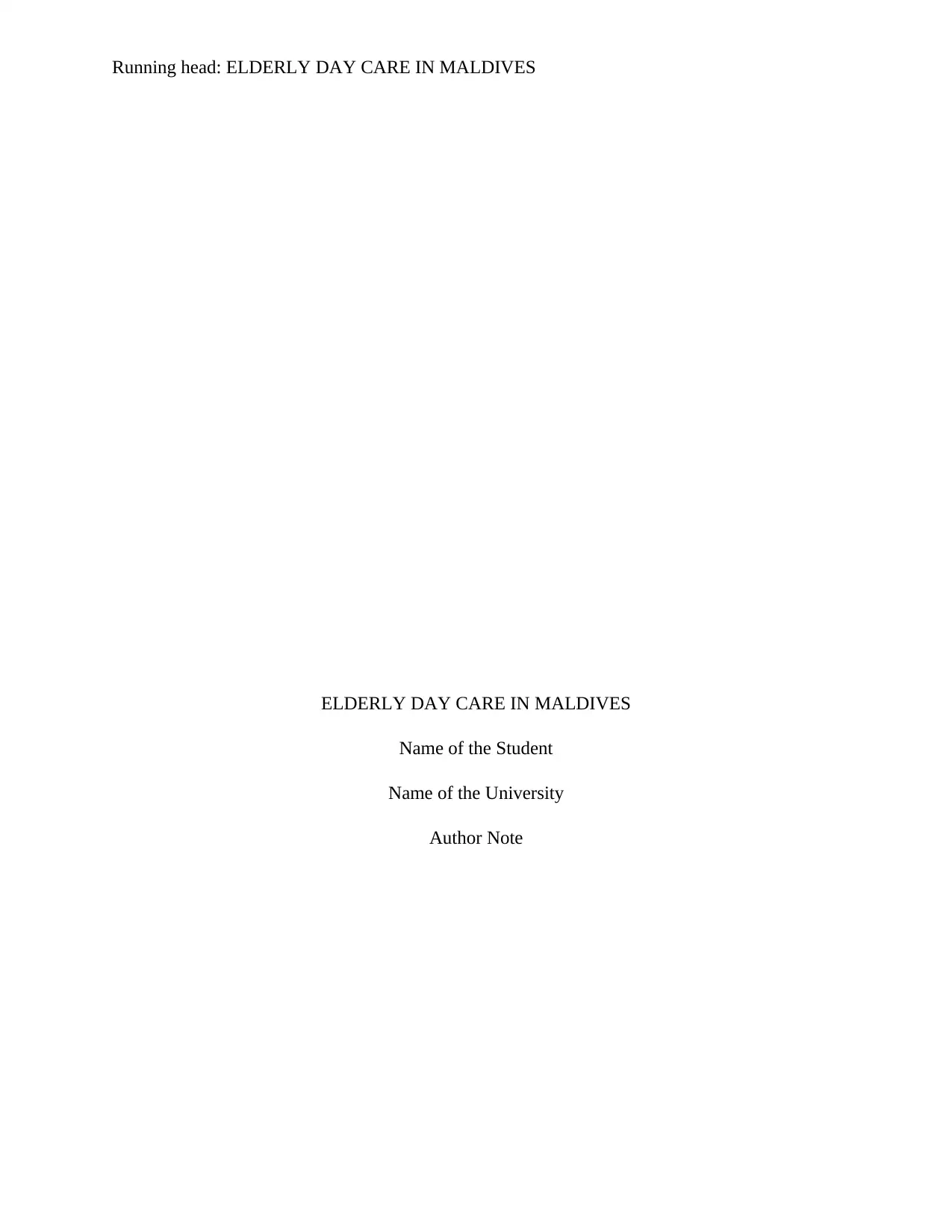
Running head: ELDERLY DAY CARE IN MALDIVES
ELDERLY DAY CARE IN MALDIVES
Name of the Student
Name of the University
Author Note
ELDERLY DAY CARE IN MALDIVES
Name of the Student
Name of the University
Author Note
Paraphrase This Document
Need a fresh take? Get an instant paraphrase of this document with our AI Paraphraser
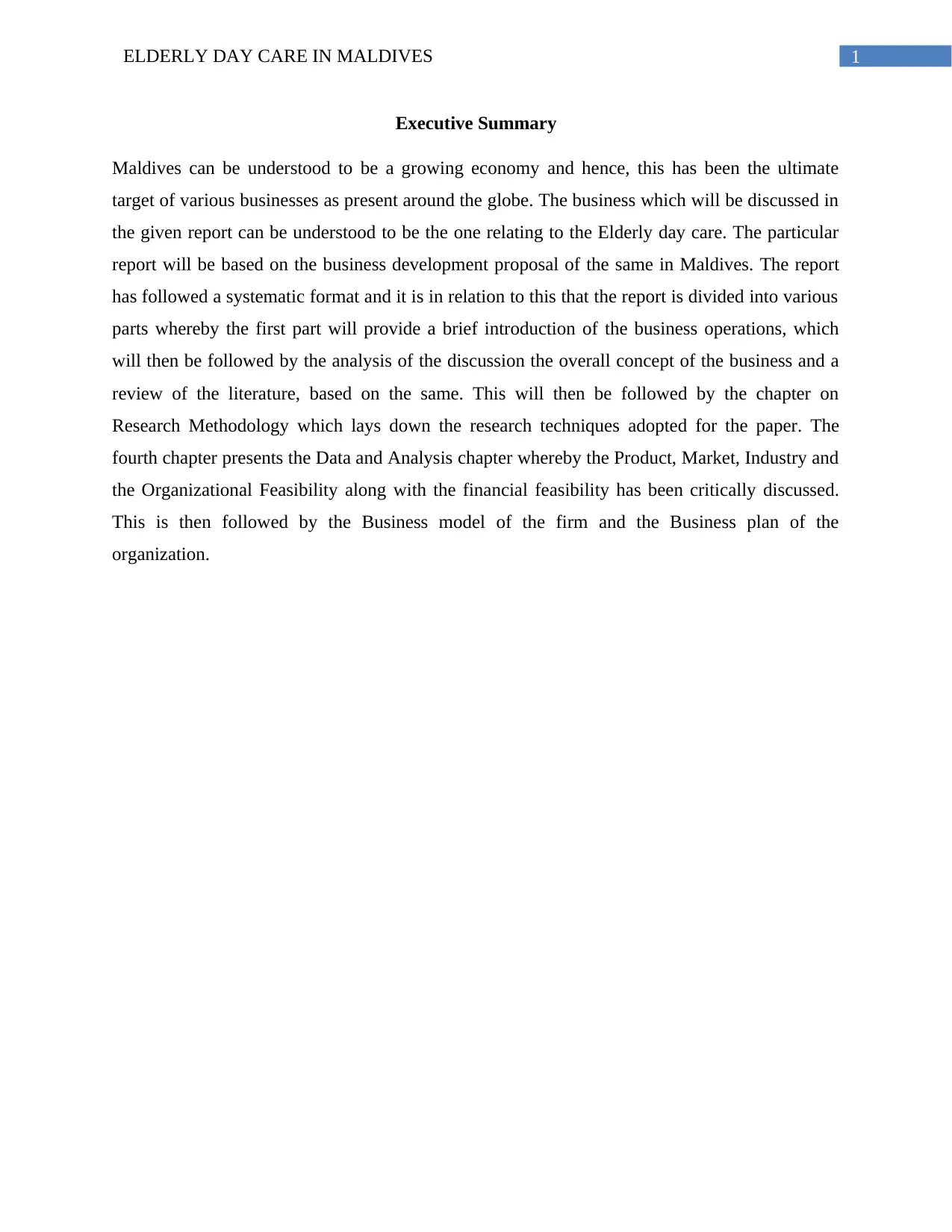
1ELDERLY DAY CARE IN MALDIVES
Executive Summary
Maldives can be understood to be a growing economy and hence, this has been the ultimate
target of various businesses as present around the globe. The business which will be discussed in
the given report can be understood to be the one relating to the Elderly day care. The particular
report will be based on the business development proposal of the same in Maldives. The report
has followed a systematic format and it is in relation to this that the report is divided into various
parts whereby the first part will provide a brief introduction of the business operations, which
will then be followed by the analysis of the discussion the overall concept of the business and a
review of the literature, based on the same. This will then be followed by the chapter on
Research Methodology which lays down the research techniques adopted for the paper. The
fourth chapter presents the Data and Analysis chapter whereby the Product, Market, Industry and
the Organizational Feasibility along with the financial feasibility has been critically discussed.
This is then followed by the Business model of the firm and the Business plan of the
organization.
Executive Summary
Maldives can be understood to be a growing economy and hence, this has been the ultimate
target of various businesses as present around the globe. The business which will be discussed in
the given report can be understood to be the one relating to the Elderly day care. The particular
report will be based on the business development proposal of the same in Maldives. The report
has followed a systematic format and it is in relation to this that the report is divided into various
parts whereby the first part will provide a brief introduction of the business operations, which
will then be followed by the analysis of the discussion the overall concept of the business and a
review of the literature, based on the same. This will then be followed by the chapter on
Research Methodology which lays down the research techniques adopted for the paper. The
fourth chapter presents the Data and Analysis chapter whereby the Product, Market, Industry and
the Organizational Feasibility along with the financial feasibility has been critically discussed.
This is then followed by the Business model of the firm and the Business plan of the
organization.
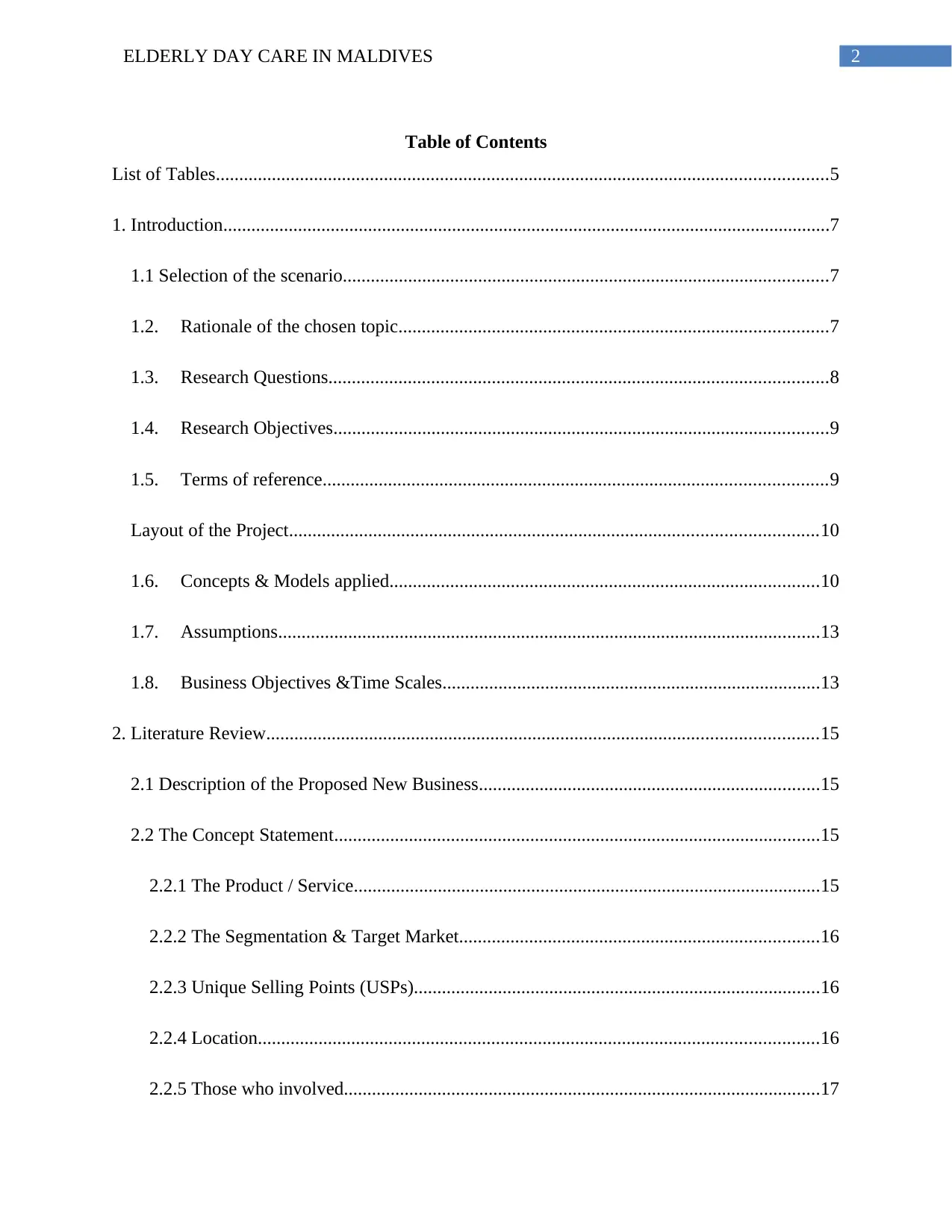
2ELDERLY DAY CARE IN MALDIVES
Table of Contents
List of Tables...................................................................................................................................5
1. Introduction..................................................................................................................................7
1.1 Selection of the scenario........................................................................................................7
1.2. Rationale of the chosen topic............................................................................................7
1.3. Research Questions...........................................................................................................8
1.4. Research Objectives..........................................................................................................9
1.5. Terms of reference............................................................................................................9
Layout of the Project.................................................................................................................10
1.6. Concepts & Models applied............................................................................................10
1.7. Assumptions....................................................................................................................13
1.8. Business Objectives &Time Scales.................................................................................13
2. Literature Review......................................................................................................................15
2.1 Description of the Proposed New Business.........................................................................15
2.2 The Concept Statement........................................................................................................15
2.2.1 The Product / Service....................................................................................................15
2.2.2 The Segmentation & Target Market.............................................................................16
2.2.3 Unique Selling Points (USPs).......................................................................................16
2.2.4 Location........................................................................................................................16
2.2.5 Those who involved......................................................................................................17
Table of Contents
List of Tables...................................................................................................................................5
1. Introduction..................................................................................................................................7
1.1 Selection of the scenario........................................................................................................7
1.2. Rationale of the chosen topic............................................................................................7
1.3. Research Questions...........................................................................................................8
1.4. Research Objectives..........................................................................................................9
1.5. Terms of reference............................................................................................................9
Layout of the Project.................................................................................................................10
1.6. Concepts & Models applied............................................................................................10
1.7. Assumptions....................................................................................................................13
1.8. Business Objectives &Time Scales.................................................................................13
2. Literature Review......................................................................................................................15
2.1 Description of the Proposed New Business.........................................................................15
2.2 The Concept Statement........................................................................................................15
2.2.1 The Product / Service....................................................................................................15
2.2.2 The Segmentation & Target Market.............................................................................16
2.2.3 Unique Selling Points (USPs).......................................................................................16
2.2.4 Location........................................................................................................................16
2.2.5 Those who involved......................................................................................................17
⊘ This is a preview!⊘
Do you want full access?
Subscribe today to unlock all pages.

Trusted by 1+ million students worldwide
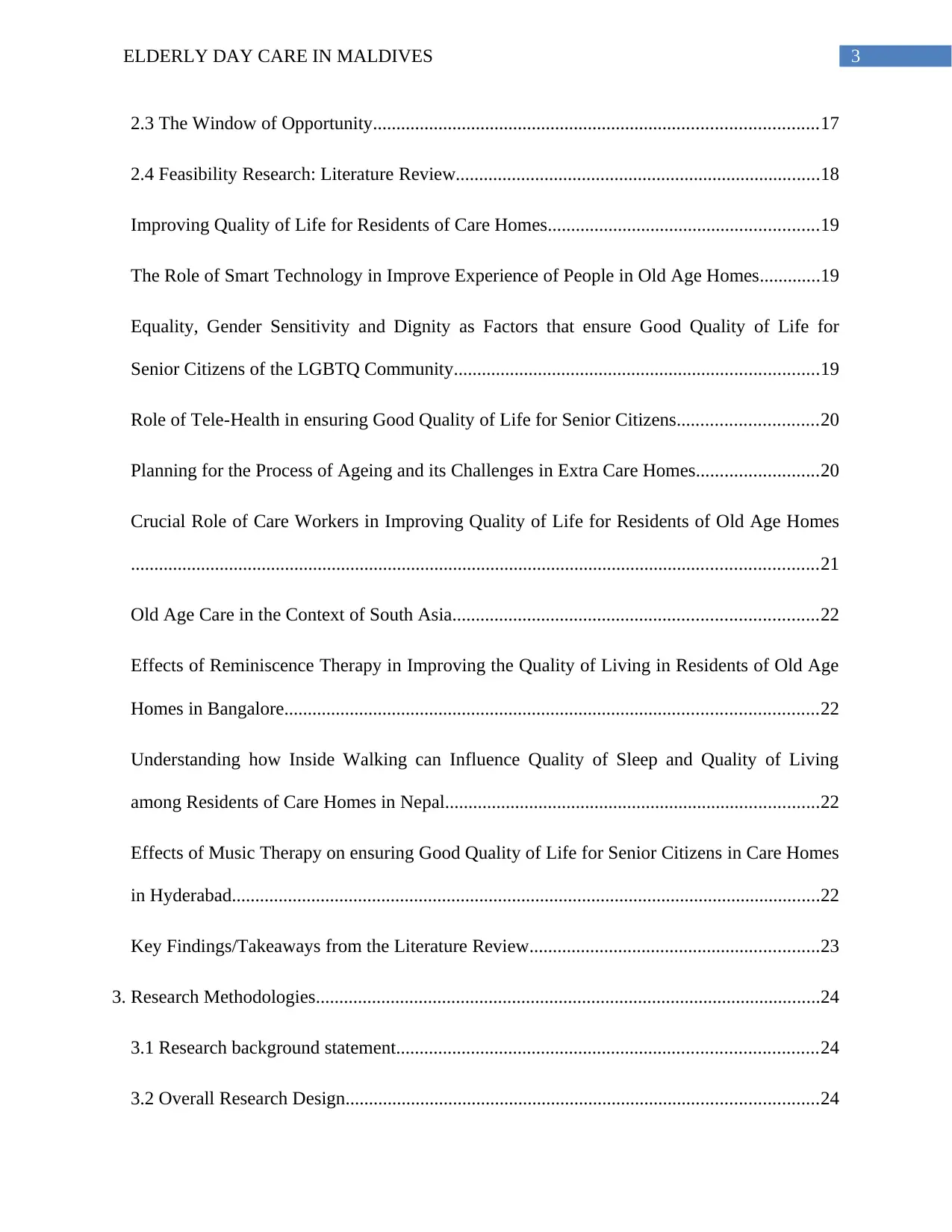
3ELDERLY DAY CARE IN MALDIVES
2.3 The Window of Opportunity...............................................................................................17
2.4 Feasibility Research: Literature Review..............................................................................18
Improving Quality of Life for Residents of Care Homes..........................................................19
The Role of Smart Technology in Improve Experience of People in Old Age Homes.............19
Equality, Gender Sensitivity and Dignity as Factors that ensure Good Quality of Life for
Senior Citizens of the LGBTQ Community..............................................................................19
Role of Tele-Health in ensuring Good Quality of Life for Senior Citizens..............................20
Planning for the Process of Ageing and its Challenges in Extra Care Homes..........................20
Crucial Role of Care Workers in Improving Quality of Life for Residents of Old Age Homes
...................................................................................................................................................21
Old Age Care in the Context of South Asia..............................................................................22
Effects of Reminiscence Therapy in Improving the Quality of Living in Residents of Old Age
Homes in Bangalore..................................................................................................................22
Understanding how Inside Walking can Influence Quality of Sleep and Quality of Living
among Residents of Care Homes in Nepal................................................................................22
Effects of Music Therapy on ensuring Good Quality of Life for Senior Citizens in Care Homes
in Hyderabad..............................................................................................................................22
Key Findings/Takeaways from the Literature Review..............................................................23
3. Research Methodologies............................................................................................................24
3.1 Research background statement..........................................................................................24
3.2 Overall Research Design.....................................................................................................24
2.3 The Window of Opportunity...............................................................................................17
2.4 Feasibility Research: Literature Review..............................................................................18
Improving Quality of Life for Residents of Care Homes..........................................................19
The Role of Smart Technology in Improve Experience of People in Old Age Homes.............19
Equality, Gender Sensitivity and Dignity as Factors that ensure Good Quality of Life for
Senior Citizens of the LGBTQ Community..............................................................................19
Role of Tele-Health in ensuring Good Quality of Life for Senior Citizens..............................20
Planning for the Process of Ageing and its Challenges in Extra Care Homes..........................20
Crucial Role of Care Workers in Improving Quality of Life for Residents of Old Age Homes
...................................................................................................................................................21
Old Age Care in the Context of South Asia..............................................................................22
Effects of Reminiscence Therapy in Improving the Quality of Living in Residents of Old Age
Homes in Bangalore..................................................................................................................22
Understanding how Inside Walking can Influence Quality of Sleep and Quality of Living
among Residents of Care Homes in Nepal................................................................................22
Effects of Music Therapy on ensuring Good Quality of Life for Senior Citizens in Care Homes
in Hyderabad..............................................................................................................................22
Key Findings/Takeaways from the Literature Review..............................................................23
3. Research Methodologies............................................................................................................24
3.1 Research background statement..........................................................................................24
3.2 Overall Research Design.....................................................................................................24
Paraphrase This Document
Need a fresh take? Get an instant paraphrase of this document with our AI Paraphraser
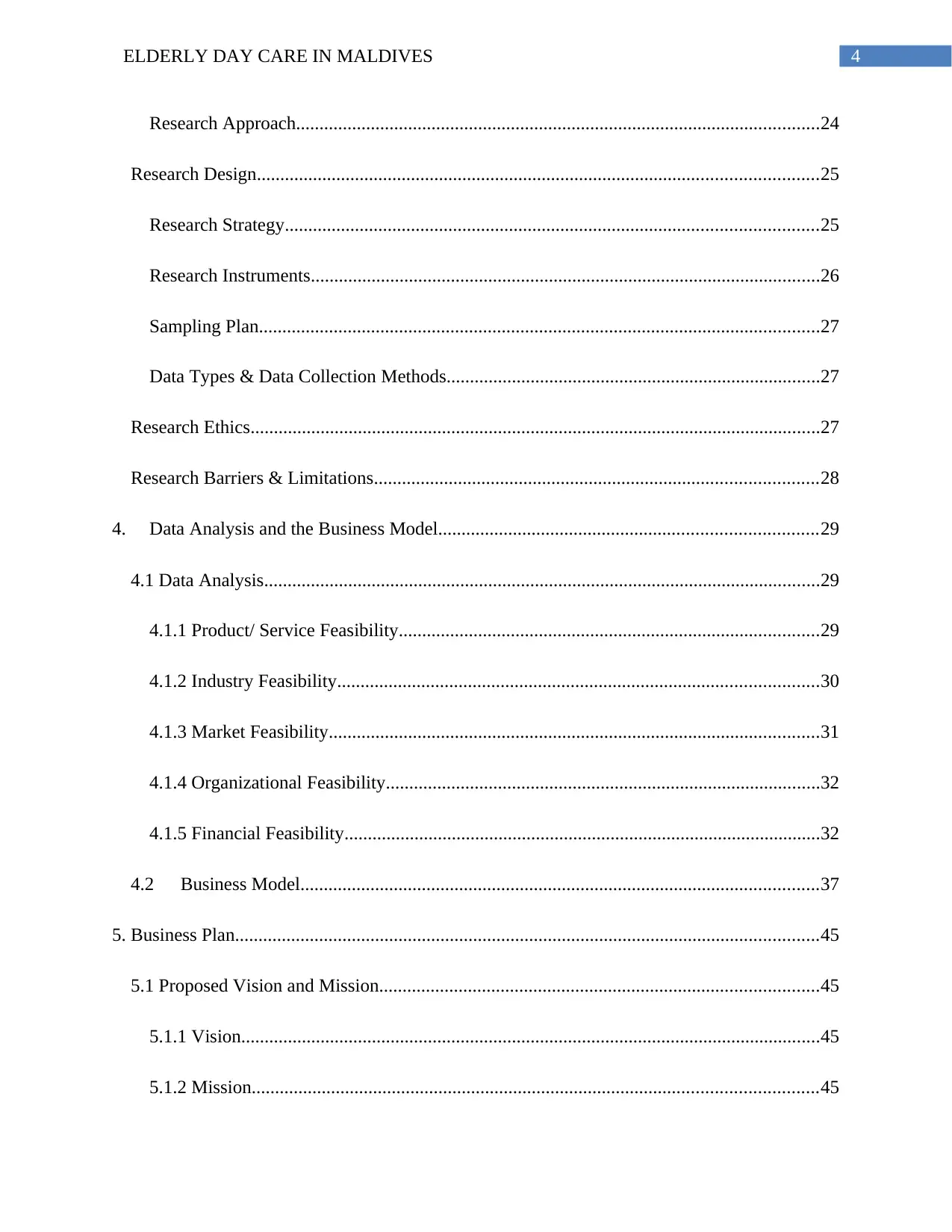
4ELDERLY DAY CARE IN MALDIVES
Research Approach................................................................................................................24
Research Design........................................................................................................................25
Research Strategy..................................................................................................................25
Research Instruments.............................................................................................................26
Sampling Plan........................................................................................................................27
Data Types & Data Collection Methods................................................................................27
Research Ethics..........................................................................................................................27
Research Barriers & Limitations...............................................................................................28
4. Data Analysis and the Business Model.................................................................................29
4.1 Data Analysis.......................................................................................................................29
4.1.1 Product/ Service Feasibility..........................................................................................29
4.1.2 Industry Feasibility.......................................................................................................30
4.1.3 Market Feasibility.........................................................................................................31
4.1.4 Organizational Feasibility.............................................................................................32
4.1.5 Financial Feasibility......................................................................................................32
4.2 Business Model...............................................................................................................37
5. Business Plan.............................................................................................................................45
5.1 Proposed Vision and Mission..............................................................................................45
5.1.1 Vision............................................................................................................................45
5.1.2 Mission.........................................................................................................................45
Research Approach................................................................................................................24
Research Design........................................................................................................................25
Research Strategy..................................................................................................................25
Research Instruments.............................................................................................................26
Sampling Plan........................................................................................................................27
Data Types & Data Collection Methods................................................................................27
Research Ethics..........................................................................................................................27
Research Barriers & Limitations...............................................................................................28
4. Data Analysis and the Business Model.................................................................................29
4.1 Data Analysis.......................................................................................................................29
4.1.1 Product/ Service Feasibility..........................................................................................29
4.1.2 Industry Feasibility.......................................................................................................30
4.1.3 Market Feasibility.........................................................................................................31
4.1.4 Organizational Feasibility.............................................................................................32
4.1.5 Financial Feasibility......................................................................................................32
4.2 Business Model...............................................................................................................37
5. Business Plan.............................................................................................................................45
5.1 Proposed Vision and Mission..............................................................................................45
5.1.1 Vision............................................................................................................................45
5.1.2 Mission.........................................................................................................................45

5ELDERLY DAY CARE IN MALDIVES
5.2 Marketing Plan.....................................................................................................................45
5.3 Operations............................................................................................................................46
5.4 Human Resource Plan..........................................................................................................49
5.5 Risk Assessment..................................................................................................................50
5.6 Financial Plan......................................................................................................................53
5.6.1 Quarterly based cash budgets.......................................................................................53
5.6.2 Budgeted Income statements...................................................................................54
5.6.3 Budgeted statement of financial position at the end of the third year.....................55
Breakeven..............................................................................................................................57
5.6.4 Sensitivity analysis for the 1st year of income........................................................58
5.6.5 Ratio analysis................................................................................................................59
5.6.6 Cost Management.........................................................................................................60
5.7 Schedule for Implementation...........................................................................................61
7. Bibliography..........................................................................................................................66
8. Appendices............................................................................................................................67
List of Tables
Table 1.6: The concepts applied....................................................................................................10
Table 4.1.5 Startup expenses.........................................................................................................32
Table 4.2: Business Canvas Model................................................................................................36
Table 5.2: 4ps of marketing...........................................................................................................45
5.2 Marketing Plan.....................................................................................................................45
5.3 Operations............................................................................................................................46
5.4 Human Resource Plan..........................................................................................................49
5.5 Risk Assessment..................................................................................................................50
5.6 Financial Plan......................................................................................................................53
5.6.1 Quarterly based cash budgets.......................................................................................53
5.6.2 Budgeted Income statements...................................................................................54
5.6.3 Budgeted statement of financial position at the end of the third year.....................55
Breakeven..............................................................................................................................57
5.6.4 Sensitivity analysis for the 1st year of income........................................................58
5.6.5 Ratio analysis................................................................................................................59
5.6.6 Cost Management.........................................................................................................60
5.7 Schedule for Implementation...........................................................................................61
7. Bibliography..........................................................................................................................66
8. Appendices............................................................................................................................67
List of Tables
Table 1.6: The concepts applied....................................................................................................10
Table 4.1.5 Startup expenses.........................................................................................................32
Table 4.2: Business Canvas Model................................................................................................36
Table 5.2: 4ps of marketing...........................................................................................................45
⊘ This is a preview!⊘
Do you want full access?
Subscribe today to unlock all pages.

Trusted by 1+ million students worldwide
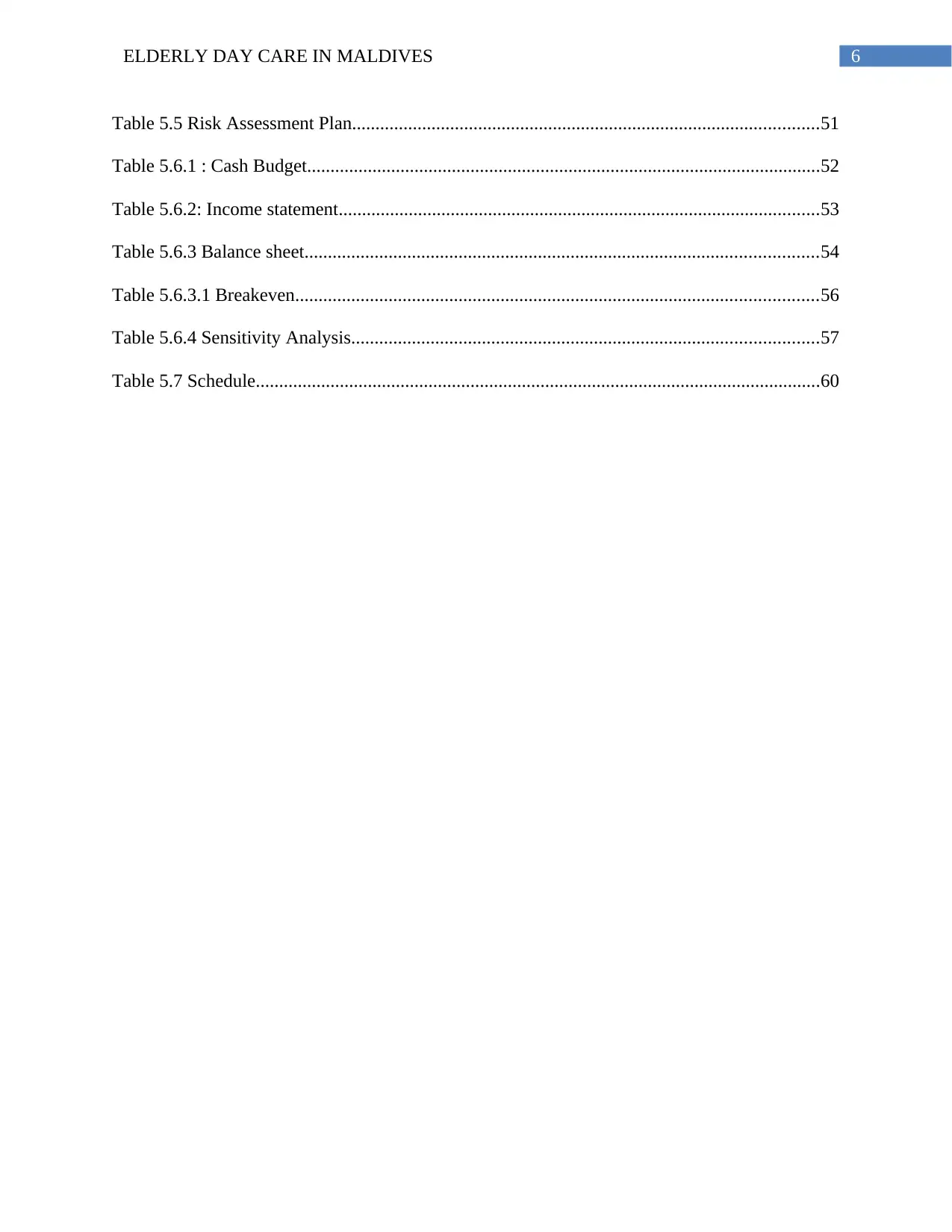
6ELDERLY DAY CARE IN MALDIVES
Table 5.5 Risk Assessment Plan....................................................................................................51
Table 5.6.1 : Cash Budget..............................................................................................................52
Table 5.6.2: Income statement.......................................................................................................53
Table 5.6.3 Balance sheet..............................................................................................................54
Table 5.6.3.1 Breakeven................................................................................................................56
Table 5.6.4 Sensitivity Analysis....................................................................................................57
Table 5.7 Schedule.........................................................................................................................60
Table 5.5 Risk Assessment Plan....................................................................................................51
Table 5.6.1 : Cash Budget..............................................................................................................52
Table 5.6.2: Income statement.......................................................................................................53
Table 5.6.3 Balance sheet..............................................................................................................54
Table 5.6.3.1 Breakeven................................................................................................................56
Table 5.6.4 Sensitivity Analysis....................................................................................................57
Table 5.7 Schedule.........................................................................................................................60
Paraphrase This Document
Need a fresh take? Get an instant paraphrase of this document with our AI Paraphraser
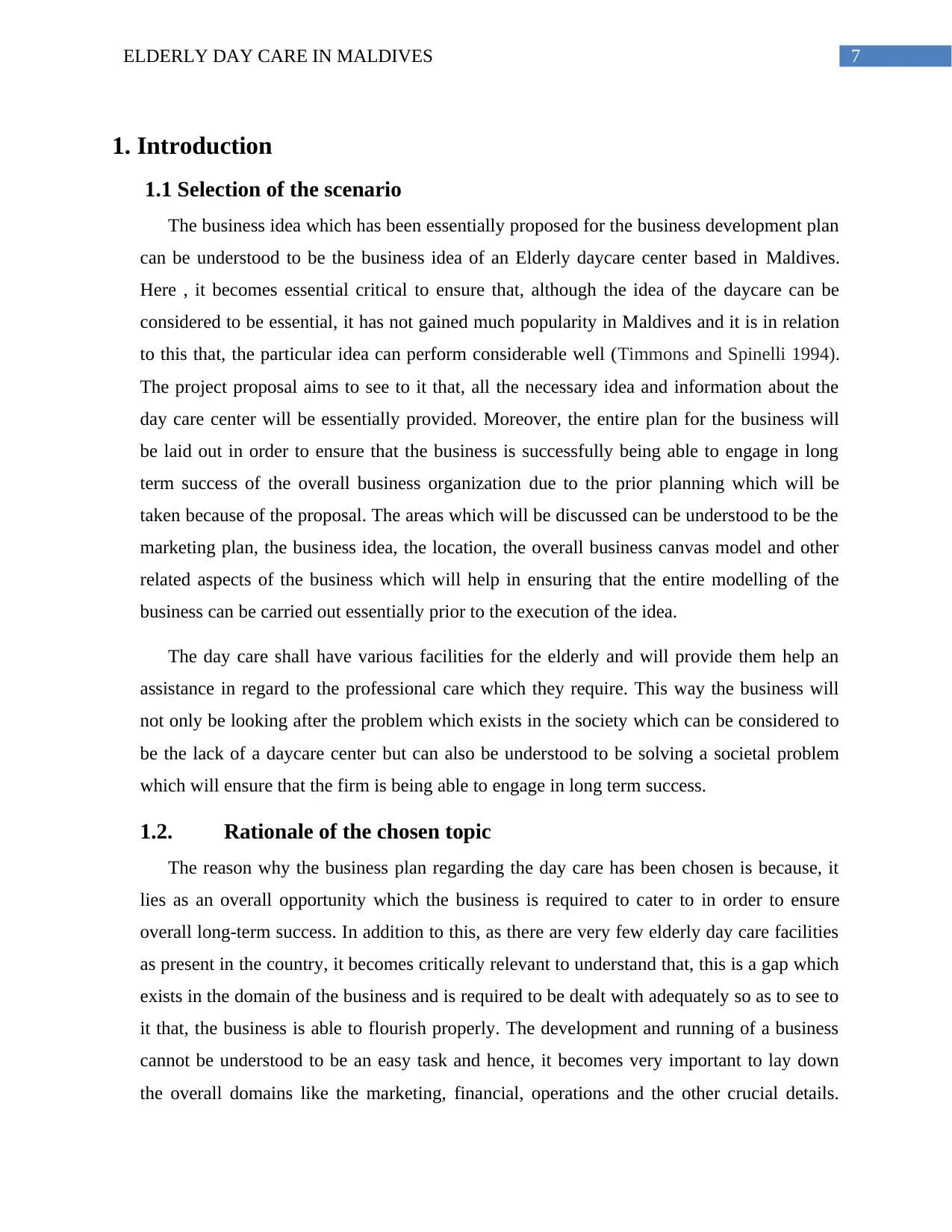
7ELDERLY DAY CARE IN MALDIVES
1. Introduction
1.1 Selection of the scenario
The business idea which has been essentially proposed for the business development plan
can be understood to be the business idea of an Elderly daycare center based in Maldives.
Here , it becomes essential critical to ensure that, although the idea of the daycare can be
considered to be essential, it has not gained much popularity in Maldives and it is in relation
to this that, the particular idea can perform considerable well (Timmons and Spinelli 1994).
The project proposal aims to see to it that, all the necessary idea and information about the
day care center will be essentially provided. Moreover, the entire plan for the business will
be laid out in order to ensure that the business is successfully being able to engage in long
term success of the overall business organization due to the prior planning which will be
taken because of the proposal. The areas which will be discussed can be understood to be the
marketing plan, the business idea, the location, the overall business canvas model and other
related aspects of the business which will help in ensuring that the entire modelling of the
business can be carried out essentially prior to the execution of the idea.
The day care shall have various facilities for the elderly and will provide them help an
assistance in regard to the professional care which they require. This way the business will
not only be looking after the problem which exists in the society which can be considered to
be the lack of a daycare center but can also be understood to be solving a societal problem
which will ensure that the firm is being able to engage in long term success.
1.2. Rationale of the chosen topic
The reason why the business plan regarding the day care has been chosen is because, it
lies as an overall opportunity which the business is required to cater to in order to ensure
overall long-term success. In addition to this, as there are very few elderly day care facilities
as present in the country, it becomes critically relevant to understand that, this is a gap which
exists in the domain of the business and is required to be dealt with adequately so as to see to
it that, the business is able to flourish properly. The development and running of a business
cannot be understood to be an easy task and hence, it becomes very important to lay down
the overall domains like the marketing, financial, operations and the other crucial details.
1. Introduction
1.1 Selection of the scenario
The business idea which has been essentially proposed for the business development plan
can be understood to be the business idea of an Elderly daycare center based in Maldives.
Here , it becomes essential critical to ensure that, although the idea of the daycare can be
considered to be essential, it has not gained much popularity in Maldives and it is in relation
to this that, the particular idea can perform considerable well (Timmons and Spinelli 1994).
The project proposal aims to see to it that, all the necessary idea and information about the
day care center will be essentially provided. Moreover, the entire plan for the business will
be laid out in order to ensure that the business is successfully being able to engage in long
term success of the overall business organization due to the prior planning which will be
taken because of the proposal. The areas which will be discussed can be understood to be the
marketing plan, the business idea, the location, the overall business canvas model and other
related aspects of the business which will help in ensuring that the entire modelling of the
business can be carried out essentially prior to the execution of the idea.
The day care shall have various facilities for the elderly and will provide them help an
assistance in regard to the professional care which they require. This way the business will
not only be looking after the problem which exists in the society which can be considered to
be the lack of a daycare center but can also be understood to be solving a societal problem
which will ensure that the firm is being able to engage in long term success.
1.2. Rationale of the chosen topic
The reason why the business plan regarding the day care has been chosen is because, it
lies as an overall opportunity which the business is required to cater to in order to ensure
overall long-term success. In addition to this, as there are very few elderly day care facilities
as present in the country, it becomes critically relevant to understand that, this is a gap which
exists in the domain of the business and is required to be dealt with adequately so as to see to
it that, the business is able to flourish properly. The development and running of a business
cannot be understood to be an easy task and hence, it becomes very important to lay down
the overall domains like the marketing, financial, operations and the other crucial details.
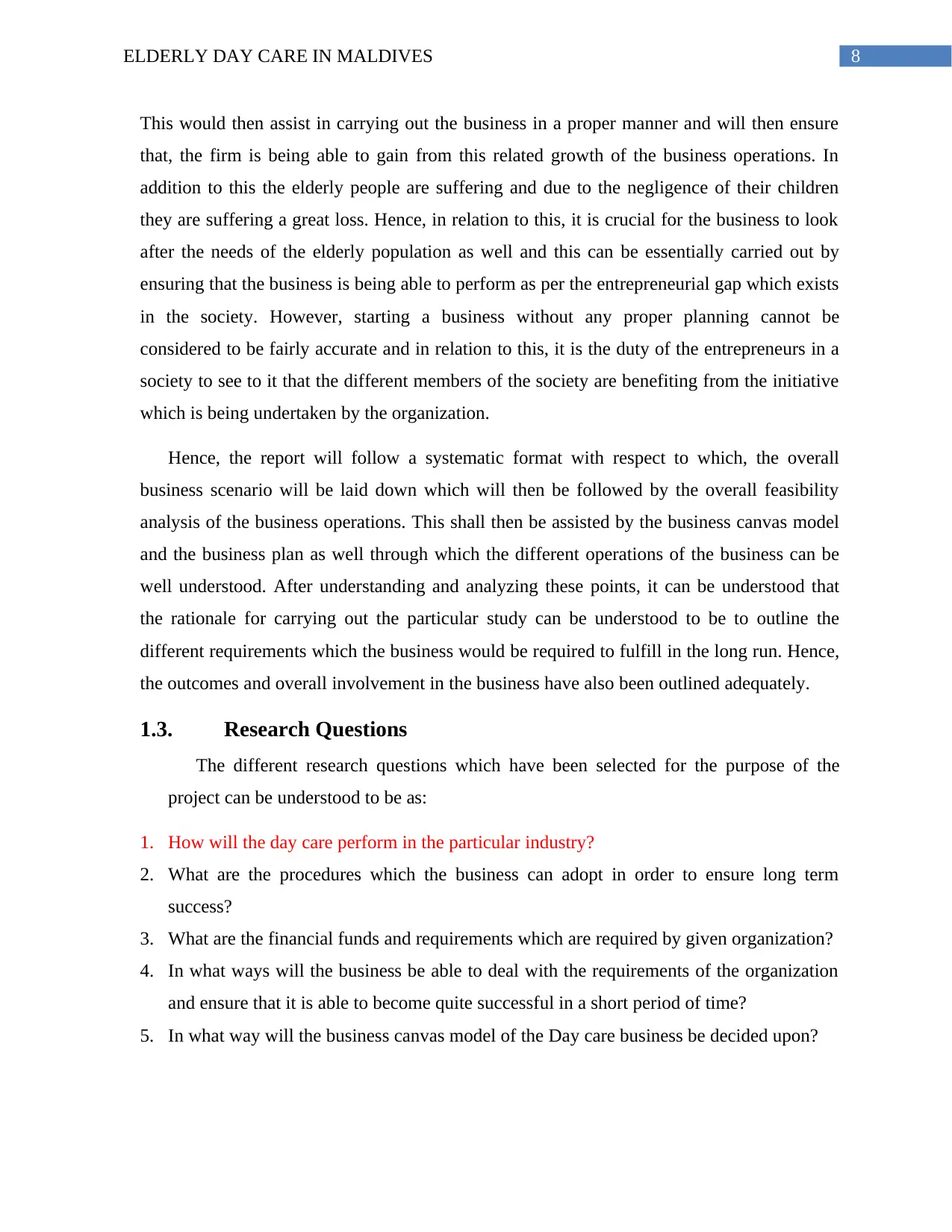
8ELDERLY DAY CARE IN MALDIVES
This would then assist in carrying out the business in a proper manner and will then ensure
that, the firm is being able to gain from this related growth of the business operations. In
addition to this the elderly people are suffering and due to the negligence of their children
they are suffering a great loss. Hence, in relation to this, it is crucial for the business to look
after the needs of the elderly population as well and this can be essentially carried out by
ensuring that the business is being able to perform as per the entrepreneurial gap which exists
in the society. However, starting a business without any proper planning cannot be
considered to be fairly accurate and in relation to this, it is the duty of the entrepreneurs in a
society to see to it that the different members of the society are benefiting from the initiative
which is being undertaken by the organization.
Hence, the report will follow a systematic format with respect to which, the overall
business scenario will be laid down which will then be followed by the overall feasibility
analysis of the business operations. This shall then be assisted by the business canvas model
and the business plan as well through which the different operations of the business can be
well understood. After understanding and analyzing these points, it can be understood that
the rationale for carrying out the particular study can be understood to be to outline the
different requirements which the business would be required to fulfill in the long run. Hence,
the outcomes and overall involvement in the business have also been outlined adequately.
1.3. Research Questions
The different research questions which have been selected for the purpose of the
project can be understood to be as:
1. How will the day care perform in the particular industry?
2. What are the procedures which the business can adopt in order to ensure long term
success?
3. What are the financial funds and requirements which are required by given organization?
4. In what ways will the business be able to deal with the requirements of the organization
and ensure that it is able to become quite successful in a short period of time?
5. In what way will the business canvas model of the Day care business be decided upon?
This would then assist in carrying out the business in a proper manner and will then ensure
that, the firm is being able to gain from this related growth of the business operations. In
addition to this the elderly people are suffering and due to the negligence of their children
they are suffering a great loss. Hence, in relation to this, it is crucial for the business to look
after the needs of the elderly population as well and this can be essentially carried out by
ensuring that the business is being able to perform as per the entrepreneurial gap which exists
in the society. However, starting a business without any proper planning cannot be
considered to be fairly accurate and in relation to this, it is the duty of the entrepreneurs in a
society to see to it that the different members of the society are benefiting from the initiative
which is being undertaken by the organization.
Hence, the report will follow a systematic format with respect to which, the overall
business scenario will be laid down which will then be followed by the overall feasibility
analysis of the business operations. This shall then be assisted by the business canvas model
and the business plan as well through which the different operations of the business can be
well understood. After understanding and analyzing these points, it can be understood that
the rationale for carrying out the particular study can be understood to be to outline the
different requirements which the business would be required to fulfill in the long run. Hence,
the outcomes and overall involvement in the business have also been outlined adequately.
1.3. Research Questions
The different research questions which have been selected for the purpose of the
project can be understood to be as:
1. How will the day care perform in the particular industry?
2. What are the procedures which the business can adopt in order to ensure long term
success?
3. What are the financial funds and requirements which are required by given organization?
4. In what ways will the business be able to deal with the requirements of the organization
and ensure that it is able to become quite successful in a short period of time?
5. In what way will the business canvas model of the Day care business be decided upon?
⊘ This is a preview!⊘
Do you want full access?
Subscribe today to unlock all pages.

Trusted by 1+ million students worldwide
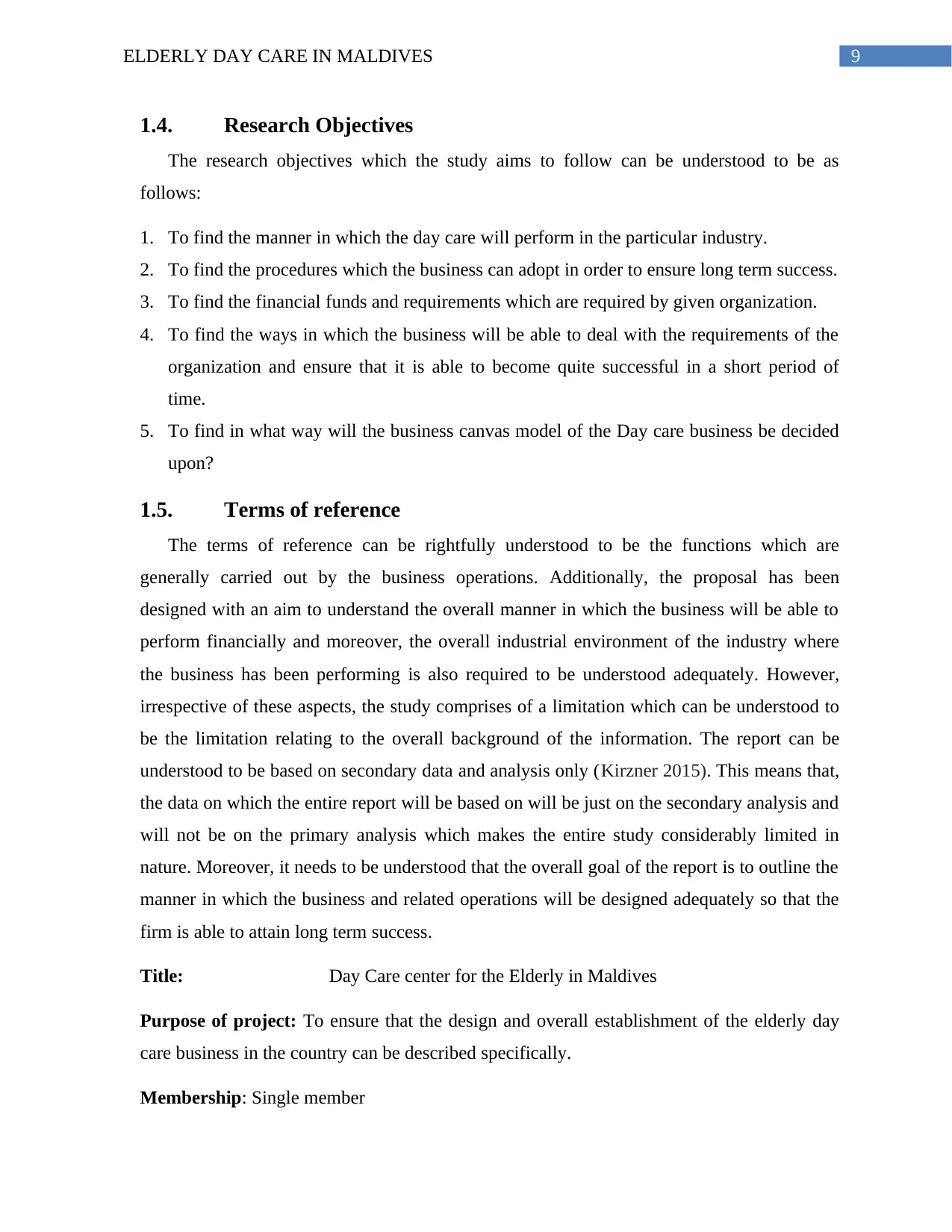
9ELDERLY DAY CARE IN MALDIVES
1.4. Research Objectives
The research objectives which the study aims to follow can be understood to be as
follows:
1. To find the manner in which the day care will perform in the particular industry.
2. To find the procedures which the business can adopt in order to ensure long term success.
3. To find the financial funds and requirements which are required by given organization.
4. To find the ways in which the business will be able to deal with the requirements of the
organization and ensure that it is able to become quite successful in a short period of
time.
5. To find in what way will the business canvas model of the Day care business be decided
upon?
1.5. Terms of reference
The terms of reference can be rightfully understood to be the functions which are
generally carried out by the business operations. Additionally, the proposal has been
designed with an aim to understand the overall manner in which the business will be able to
perform financially and moreover, the overall industrial environment of the industry where
the business has been performing is also required to be understood adequately. However,
irrespective of these aspects, the study comprises of a limitation which can be understood to
be the limitation relating to the overall background of the information. The report can be
understood to be based on secondary data and analysis only (Kirzner 2015). This means that,
the data on which the entire report will be based on will be just on the secondary analysis and
will not be on the primary analysis which makes the entire study considerably limited in
nature. Moreover, it needs to be understood that the overall goal of the report is to outline the
manner in which the business and related operations will be designed adequately so that the
firm is able to attain long term success.
Title: Day Care center for the Elderly in Maldives
Purpose of project: To ensure that the design and overall establishment of the elderly day
care business in the country can be described specifically.
Membership: Single member
1.4. Research Objectives
The research objectives which the study aims to follow can be understood to be as
follows:
1. To find the manner in which the day care will perform in the particular industry.
2. To find the procedures which the business can adopt in order to ensure long term success.
3. To find the financial funds and requirements which are required by given organization.
4. To find the ways in which the business will be able to deal with the requirements of the
organization and ensure that it is able to become quite successful in a short period of
time.
5. To find in what way will the business canvas model of the Day care business be decided
upon?
1.5. Terms of reference
The terms of reference can be rightfully understood to be the functions which are
generally carried out by the business operations. Additionally, the proposal has been
designed with an aim to understand the overall manner in which the business will be able to
perform financially and moreover, the overall industrial environment of the industry where
the business has been performing is also required to be understood adequately. However,
irrespective of these aspects, the study comprises of a limitation which can be understood to
be the limitation relating to the overall background of the information. The report can be
understood to be based on secondary data and analysis only (Kirzner 2015). This means that,
the data on which the entire report will be based on will be just on the secondary analysis and
will not be on the primary analysis which makes the entire study considerably limited in
nature. Moreover, it needs to be understood that the overall goal of the report is to outline the
manner in which the business and related operations will be designed adequately so that the
firm is able to attain long term success.
Title: Day Care center for the Elderly in Maldives
Purpose of project: To ensure that the design and overall establishment of the elderly day
care business in the country can be described specifically.
Membership: Single member
Paraphrase This Document
Need a fresh take? Get an instant paraphrase of this document with our AI Paraphraser
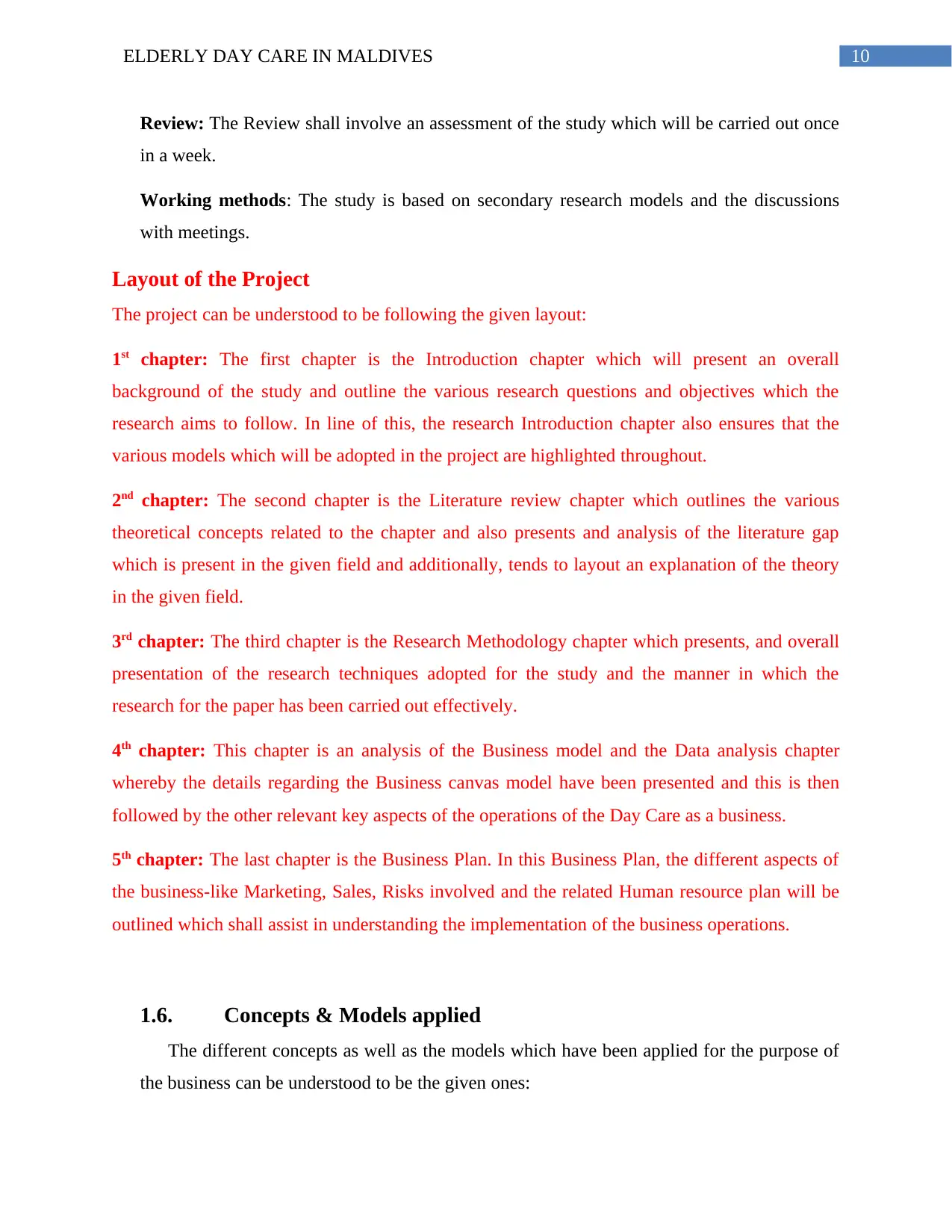
10ELDERLY DAY CARE IN MALDIVES
Review: The Review shall involve an assessment of the study which will be carried out once
in a week.
Working methods: The study is based on secondary research models and the discussions
with meetings.
Layout of the Project
The project can be understood to be following the given layout:
1st chapter: The first chapter is the Introduction chapter which will present an overall
background of the study and outline the various research questions and objectives which the
research aims to follow. In line of this, the research Introduction chapter also ensures that the
various models which will be adopted in the project are highlighted throughout.
2nd chapter: The second chapter is the Literature review chapter which outlines the various
theoretical concepts related to the chapter and also presents and analysis of the literature gap
which is present in the given field and additionally, tends to layout an explanation of the theory
in the given field.
3rd chapter: The third chapter is the Research Methodology chapter which presents, and overall
presentation of the research techniques adopted for the study and the manner in which the
research for the paper has been carried out effectively.
4th chapter: This chapter is an analysis of the Business model and the Data analysis chapter
whereby the details regarding the Business canvas model have been presented and this is then
followed by the other relevant key aspects of the operations of the Day Care as a business.
5th chapter: The last chapter is the Business Plan. In this Business Plan, the different aspects of
the business-like Marketing, Sales, Risks involved and the related Human resource plan will be
outlined which shall assist in understanding the implementation of the business operations.
1.6. Concepts & Models applied
The different concepts as well as the models which have been applied for the purpose of
the business can be understood to be the given ones:
Review: The Review shall involve an assessment of the study which will be carried out once
in a week.
Working methods: The study is based on secondary research models and the discussions
with meetings.
Layout of the Project
The project can be understood to be following the given layout:
1st chapter: The first chapter is the Introduction chapter which will present an overall
background of the study and outline the various research questions and objectives which the
research aims to follow. In line of this, the research Introduction chapter also ensures that the
various models which will be adopted in the project are highlighted throughout.
2nd chapter: The second chapter is the Literature review chapter which outlines the various
theoretical concepts related to the chapter and also presents and analysis of the literature gap
which is present in the given field and additionally, tends to layout an explanation of the theory
in the given field.
3rd chapter: The third chapter is the Research Methodology chapter which presents, and overall
presentation of the research techniques adopted for the study and the manner in which the
research for the paper has been carried out effectively.
4th chapter: This chapter is an analysis of the Business model and the Data analysis chapter
whereby the details regarding the Business canvas model have been presented and this is then
followed by the other relevant key aspects of the operations of the Day Care as a business.
5th chapter: The last chapter is the Business Plan. In this Business Plan, the different aspects of
the business-like Marketing, Sales, Risks involved and the related Human resource plan will be
outlined which shall assist in understanding the implementation of the business operations.
1.6. Concepts & Models applied
The different concepts as well as the models which have been applied for the purpose of
the business can be understood to be the given ones:
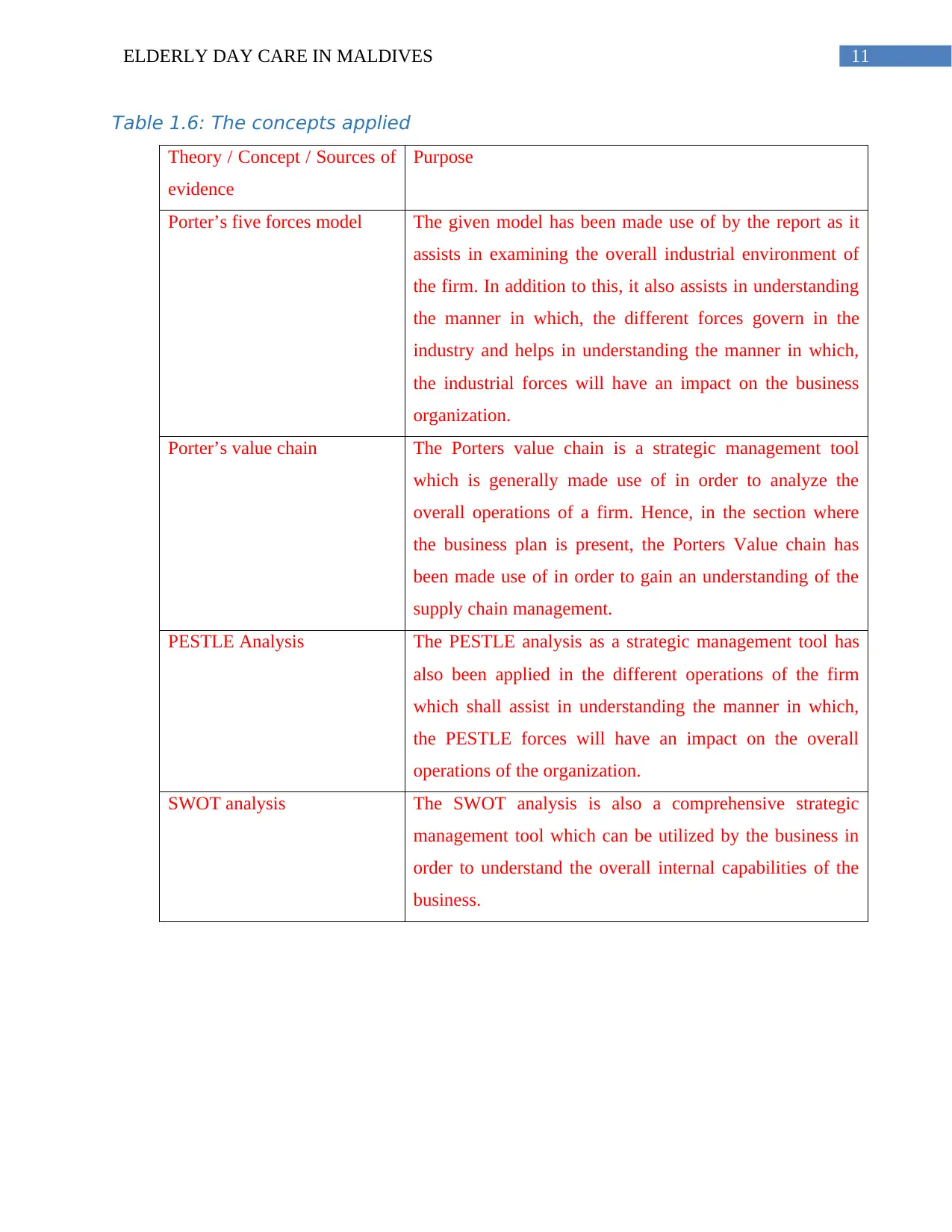
11ELDERLY DAY CARE IN MALDIVES
Table 1.6: The concepts applied
Theory / Concept / Sources of
evidence
Purpose
Porter’s five forces model The given model has been made use of by the report as it
assists in examining the overall industrial environment of
the firm. In addition to this, it also assists in understanding
the manner in which, the different forces govern in the
industry and helps in understanding the manner in which,
the industrial forces will have an impact on the business
organization.
Porter’s value chain The Porters value chain is a strategic management tool
which is generally made use of in order to analyze the
overall operations of a firm. Hence, in the section where
the business plan is present, the Porters Value chain has
been made use of in order to gain an understanding of the
supply chain management.
PESTLE Analysis The PESTLE analysis as a strategic management tool has
also been applied in the different operations of the firm
which shall assist in understanding the manner in which,
the PESTLE forces will have an impact on the overall
operations of the organization.
SWOT analysis The SWOT analysis is also a comprehensive strategic
management tool which can be utilized by the business in
order to understand the overall internal capabilities of the
business.
Table 1.6: The concepts applied
Theory / Concept / Sources of
evidence
Purpose
Porter’s five forces model The given model has been made use of by the report as it
assists in examining the overall industrial environment of
the firm. In addition to this, it also assists in understanding
the manner in which, the different forces govern in the
industry and helps in understanding the manner in which,
the industrial forces will have an impact on the business
organization.
Porter’s value chain The Porters value chain is a strategic management tool
which is generally made use of in order to analyze the
overall operations of a firm. Hence, in the section where
the business plan is present, the Porters Value chain has
been made use of in order to gain an understanding of the
supply chain management.
PESTLE Analysis The PESTLE analysis as a strategic management tool has
also been applied in the different operations of the firm
which shall assist in understanding the manner in which,
the PESTLE forces will have an impact on the overall
operations of the organization.
SWOT analysis The SWOT analysis is also a comprehensive strategic
management tool which can be utilized by the business in
order to understand the overall internal capabilities of the
business.
⊘ This is a preview!⊘
Do you want full access?
Subscribe today to unlock all pages.

Trusted by 1+ million students worldwide
1 out of 72
Related Documents
Your All-in-One AI-Powered Toolkit for Academic Success.
+13062052269
info@desklib.com
Available 24*7 on WhatsApp / Email
![[object Object]](/_next/static/media/star-bottom.7253800d.svg)
Unlock your academic potential
Copyright © 2020–2026 A2Z Services. All Rights Reserved. Developed and managed by ZUCOL.





